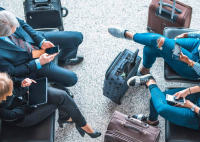
We’ve all had this happen: You’re on your laptop in some public or semi-private place. And while your document might not exactly be national security, it is certainly sensitive enough to warrant viewing by your-eyes-only. But then you happen to notice that person – the one seated next to you, or who comes over to your desk, or who pauses as they pass by your laptop. Their eyes drag across your screen and you can literally feel the data being leaked.
Amazingly, even with the miles of vendor booths at the RSA Conference, few commercial solutions exist to address this problem – beyond perhaps just putting your hands over your screen or closing down your laptop. This is surprising, because the problem seems so pervasive and modern technology certainly exists to use facial recognition as the basis for enforcing a desired eyes-only policy for what’s on your personal screen.
It was with this in mind that the TAG Cyber team spent Zoom time last week with Dexter Caffey, founder and CEO of a start-up called Smart Eye Technology. Our longtime friend and colleague Robin Bienfait had suggested that we might find the company interesting – and after meeting with their creative founder, we had to agree. Here’s a brief summary of what we learned from him about addressing this problem using biometric authentication.
“Our team at Smart Eye has built what we call a continuous, multi-level biometric security solution that helps our customers keep their documents private,” Caffey explained. “The goal is to block screen snooping so that sensitive information on a computer or mobile screen is not disclosed to some unauthorized individual. We provide this protection at Smart Eye technology all on a single platform.”
The idea apparently hit Caffey back in 2017 while attending a cyber security event in Israel. While seating in the audience, he had precisely the screen-snooping experience referenced above, and decided that this was something that had to be addressed. A year later, Smart Eye Technology was born. Located in Atlanta, Caffey is now growing the firm – and hopes to provide this type of security for both individuals users and business customers.
The solution consists of an app and Smart Eye control panel for business. The app authenticates viewers based on biometric facial, fingerprint, or voice recognition. If someone who has not been authenticated is detected looking at your computer or device, then the screen is immediately blocked by the app, and a warning message is given. (One can’t help but chuckle at the surprised expression on that nosey colleague’s face should this happen.)
The control panel also includes flexible options for setting security policy based on the needs of the individual and group. “We support the ability to accept or deny viewing requests based on collaborative needs between organizations,” Caffey explained. “And we include fine-grained policy controls on our panel based on dates, times, document types, files, Active Directory settings, and other relevant information.”
We asked Caffey about some use-cases and he discussed how the app doesn’t just prevent snooping, but also enables a variety of file sharing options such as photos, videos, and pretty much any type of document one will find, including PDFs and Microsoft Word documents. The solution works on both laptops and desktops, and the App is available on the Apple App Store and Google Play Store. This all sounded quite convenient.
From our perspective as industry analysts, we couldn’t help but think about the many privacy standards and frameworks that exist today, and that are largely silent on this matter. One can only expect that as Smart Eye grows that it will find considerable interest in the privacy community, and they’ve apparently already begun to provide a complementary e-signature capability that should be useful for standards such as HIPAA or PCI-DSS.
If this all sounds as interesting to you as it did to us, then drop a line to Dexter Caffey and his team on their website. Ask to see a demo, and we suspect that soon you might be feeling more comfortable reading documents and working on your laptop on trains, at conferences, and even at work. As always, please be sure to share with us your experiences after you’ve looked into this fine technology.
Stay safe and healthy.


